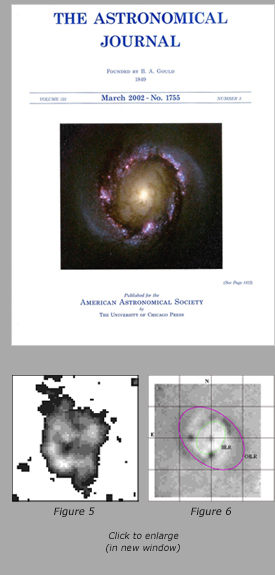Home | Extragalactic Astronomy | Education & Public Outreach
Why is NGC 4314 so interesting?
 I am involved in a long-term project to understand the morphology of NGC 4314. My earliest effort (Paper 0) involved
UBV surface photometry with an image dissector scanner. More recent work includes BVIJHK surface photometry (Paper I),
high-resolution I- band HST surface photometry (Paper II) and CO interferometry (Paper III). The HST WFPC-2 UBVIH-alpha
surface photometry obtained in late 1995 are now reduced, analyzed and available.
I am involved in a long-term project to understand the morphology of NGC 4314. My earliest effort (Paper 0) involved
UBV surface photometry with an image dissector scanner. More recent work includes BVIJHK surface photometry (Paper I),
high-resolution I- band HST surface photometry (Paper II) and CO interferometry (Paper III). The HST WFPC-2 UBVIH-alpha
surface photometry obtained in late 1995 are now reduced, analyzed and available.
 The major components of this galaxy are nuclear bulge and primary bar
The major components of this galaxy are nuclear bulge and primary bar
Details of the star formation processes within galaxies are not well understood. NGC 4314 provides a laboratory within
which to identify and study star formation mechanisms. Its nuclear ring is an Inner Lindblad Resonance (ILR), and is likely
composed of an inner and outer ILR, as evidenced by our CO interferometry of the nucleus [CO intensity map]
Accurate intrinsic colors could allow identification of which family of orbits the outer ILR belongs and provide useful constraints for theories of resonance-driven star formation. As simple as is NGC 4314 (SBa), to permit an accurate separation of new stars from old requires photometric decomposition.
The disk component is the key to decomposition and is the major goal of some proposed observations to be carried out at McDonald Observatory, using a Prime Focus CCD Camera with a 45 arcmin field. Once we have disk parameters, we can model the bulge. Once we have the bulge parameters, we can model the primary stellar bar and subtract bulge, bar, and disk contributions to obtain precise colors at the locations of new star formation.
Eventually I hope to have gifs in bandpasses ranging from 400nm to 2 mm.
Unsharp Masking
Unsharp masking is a digital image processing technique used to enhance small scale structure. The technique has long been used in the digital domain (Rosenfeld & Weszka 1976) to bring out high spatial frequency detail in 2-D array data (c.f. Benedict 1982). For this application, no attempts have been made to preserve the photometric content of the resulting frames. They are useful only for enhancing smaller scale structure. For these CCD frames, either a 17x17 pixel boxcar or a 1-s = 3 arcsec (extending 4s) kernel was used to produce the low-pass map. To further reduce the chances of enhancing noise, we averaged together the B, V, and I images to make a new full CCD frame and then applied the masking technique.
One approach often used when dissecting a galaxy is to first model the geometrically simple components (i.e., the bulge, disk, and bar) and then subtract these from the galaxy. By doing so, unmodelled components, such as spiral arms and rings, can be more easily studied. Unsharp masking is a 'dime-store' version of this approach in the sense of reduced computing facilities and time.
The figure shows the results of unsharp masking NGC 4314. We note that the enhancement process has increased the visibility of the outer dust lanes in the bar, especially to the northwest. The spiral nature of the material just outside the nuclear ring is easily seen. The nuclear spiral arms end abruptly just before they would have crossed the dust lanes in the bar. Their inner ends coincide with the ring. Possible dust arcs can be seen just exterior to the inner spiral at PA = 120° and 300°.
Note the multiple concentrations within the bar, which, with the exception of the "blobs" at the ends of the bar, were unexpected. We also detect shells of relative excess stellar material in the lens, especially strong to the N (RA = 12h 22m 34s, DEC = +29° 54" 30'). The shells are similar, in shape and location, to the supposed inner arms seen in a low contrast print of NGC 5101 (Laustsen et al. 1987). They are also similar to the inner ring of NGC 1433 (Buta 1986). Finally, note a band of relative stellar deficiency outlining the bulge and bar.
The only structures in this map which are solely a result of the sharpening process are the halos around the foreground stars. These halos change size as we vary the smoothing used to produce the low-pass map. None of the other structures change shape, size, or location as the characteristics of the low-pass map are varied.
Astronomy Program · The University of Texas at Austin · Austin, Texas 78712
prospective student inquiries: studentinfo@astro.as.utexas.edu
site comments: www@www.as.utexas.edu